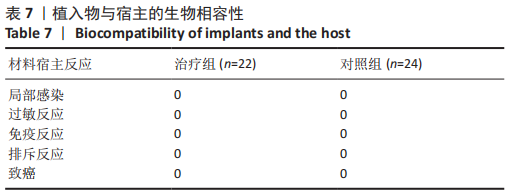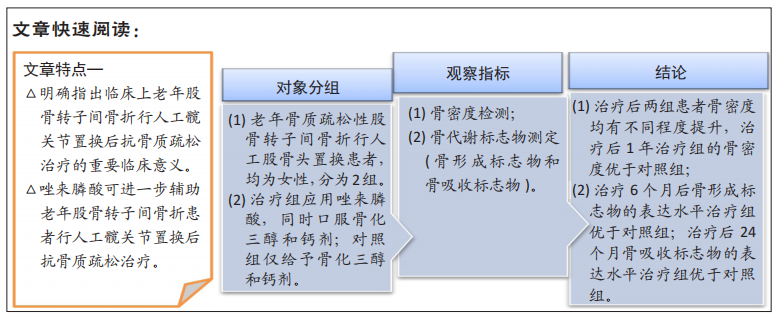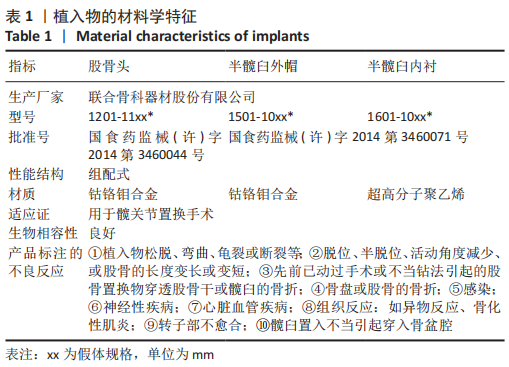2.1 参与者数量分析 纳入行人工髋关节置换的骨质疏松性股骨转子间骨折女性患者69例,根据术后治疗方案分为2组。治疗组31例患者术后使用唑来膦酸(每年1次,共输注3次),并规律口服骨化三醇及钙尔奇D抗骨质疏松治疗,其中有9例患者因治疗方案不同或失访被排除。对照组38例患者术后未使用唑来膦酸,仅以骨化三醇及钙尔奇D规律口服抗骨质疏松治疗,其中14例患者因治疗方案不同或失访被排除。
2.2 试验流程图 见图1。
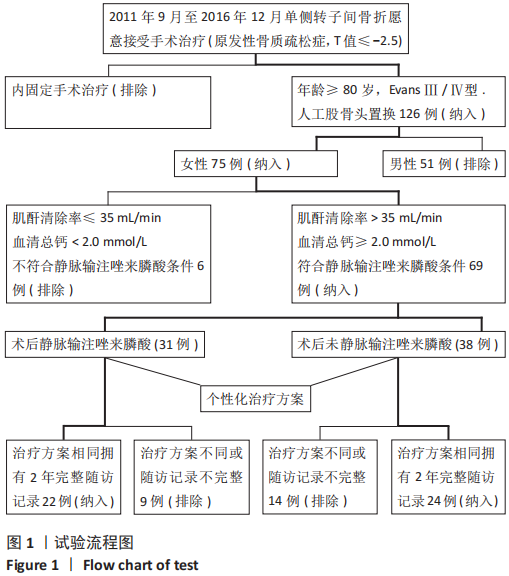
2.3 基线资料比较 术前两组病例的年龄、体质量指数、健侧髋关节骨密度、血清骨钙素、血清TRACP-5b水平相比,差异均无显著性意义(P > 0.05),见表2。
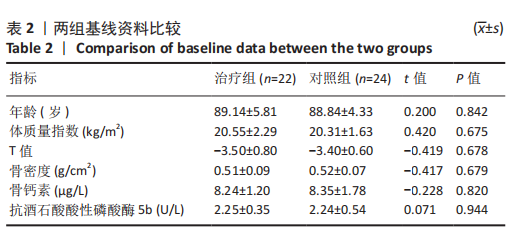
2.4 术后情况 术后卧床期间指导患者行患肢功能锻炼,卧床时间3-10 d,平均(6.8±1.2) d。所有患者均于术后6,12,24个月获得随访,对健侧髋关节骨密度、血清骨钙素、血清TRACP-5b水平进行检测,两组治疗前后各指标情况见表3-5。
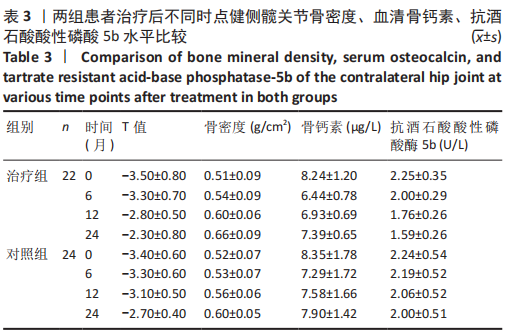
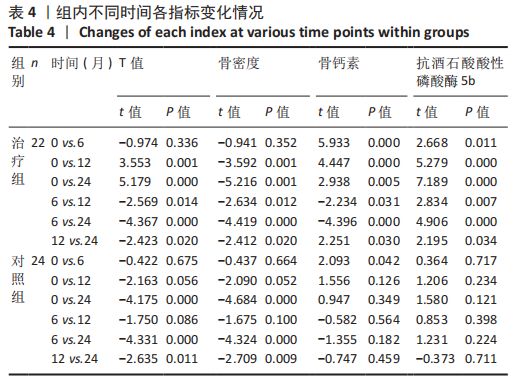
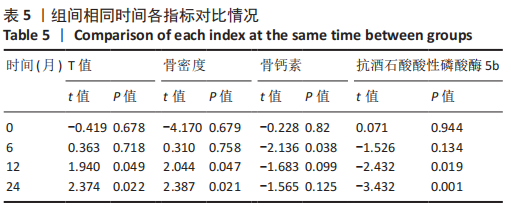
2.4.1 骨密度变化
(1) T值变化情况:见图2。
治疗组:术后6个月T值自术前-3.5±0.8上升至-3.3±
0.7,与治疗前相比差异无显著性意义(P=0.336);术后12个月T值变化至-2.8±0.5,与治疗前相比差异有显著性意义(P=0.001);术后24个月T值变化至-2.3±0.8,与治疗前相比差异有显著性意义(P=0.000);术后6个月与术后12个月之间差异有显著性意义(P=0.014);术后6个月与术后24个月之间差异有显著性意义(P=0.000);术后12个月与术后24个月之间差异有显著性意义(P=0.020)。
对照组:术后6个月T值自术前-3.4±0.6上升至-3.3±
0.6,与治疗前相比差异无显著性意义(P=0.675);术后12个月T值变化至-3.1±0.5,与治疗前相比差异无显著性意义(P=0.056);术后24个月T值变化至-2.7±0.4,与治疗前相比差异有显著性意义(P=0.000);术后6个月与术后12个月之间的差异无显著性意义(P=0.086);术后6个月与术后24个月之间的差异有显著性意义(P=0.000);术后12个月与术后24个月之间的差异有显著性意义(P=0.011)。
相同随访时间两组T值对比:术后6个月两组T值相比差异无显著性意义(P=0.718);术后12个月两组T值相比差异有显著性意义(P=0.049);术后24个月两组T值相比差异有显著性意义(P=0.022)。
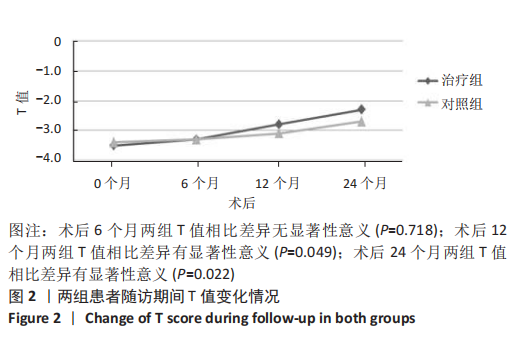
(2) 骨密度值变化情况:见图3。
治疗组:术后6个月骨密度自术前(0.51±0.09) g/cm2上升至(0.54±0.09) g/cm2,与治疗前相比差异无显著性意义(P=0.352);术后12个月骨密度变化至(0.60±0.06) g/cm2,与治疗前相比差异有显著性意义(P=0.001);术后24个月骨密度变化至(0.66±0.09) g/cm2,与治疗前相比差异有显著性意义(P=0.001);术后6个月与术后12个月之间的差异有显著性意义(P=0.012);术后6个月与术后24个月之间的差异有显著性意义(P=0.000);术后12个月与术后24个月之间的差异有显著性意义(P=0.02)。
对照组:术后6个月骨密度自术前(0.52±0.07) g/cm2上升至(0.53±0.07) g/cm2,与治疗前相比差异无显著性意义(P=0.664);术后12个月骨密度变化至(0.56±0.06) g/cm2,与治疗前相比差异无显著性意义(P=0.052);术后24个月骨密度变化至(0.60±0.05) g/cm2,与治疗前相比差异有显著性意义(P=0.000);术后6个月与术后12个月之间的差异无显著性意义(P=0.10);术后6个月与术后24个月之间的差异有显著性意义(P=0.000);术后12个月与术后24个月之间的差异有显著性意义(P=0.009)。
相同随访时间两组骨密度值对比:术后6个月两组骨密度值相比差异无显著性意义(P=0.758);术后12个月两组骨密度值相比差异有显著性意义(P=0.047);术后24个月两组骨密度值相比差异有显著性意义(P=0.021)。
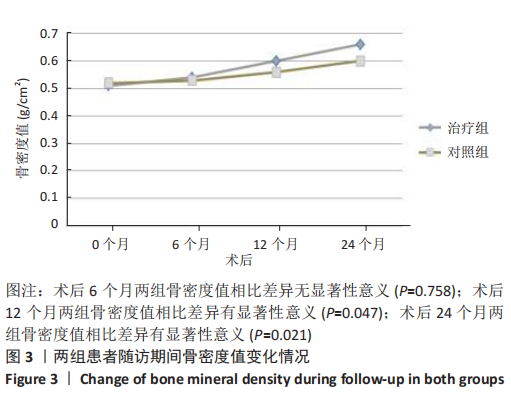
2.4.2 骨代谢标志物变化
(1)血清骨钙素变化情况:见图4。
治疗组:术后6个月骨钙素自术前(8.25±1.20) μg/L下
降至(6.44±0.78) μg/L,与治疗前相比差异有显著性意义(P=0.000);术后12个月骨钙素变化至(6.93±0.69) μg/L,与治疗前相比差异有显著性意义(P=0.000);术后24个月骨钙素变化至(7.39±0.65) μg/L,与治疗前相比差异有显著性意义(P=0.005);术后6个月与术后12个月之间的差异有显著性意义(P=0.031);术后6个月与术后24个月之间的差异有显著性意义(P=0.000);术后12个月与术后24个月之间的差异有显著性意义(P=0.030)。
对照组:术后6个月骨钙素自术前(8.35±1.78) μg/L下
降至(7.29±1.72) μg/L,与治疗前相比差异有显著性意义(P=0.042);术后12个月骨钙素变化至(7.58±1.66) μg/L,与治疗前相比差异无显著性意义(P=0.126);术后24个月骨钙素变化至(7.90±1.42) μg/L,与治疗前相比差异无显著性意义(P=0.349);术后6个月与术后12个月之间的差异无显著性意义(P=0.564);术后6个月与术后24个月之间的差异无显著性意义(P=0.182);术后12个月与术后24个月之间的差异无显著性意义(P=0.459)。
相同随访时间两组骨钙素值对比:术后6个月两组骨钙素值相比差异有显著性意义(P=0.038);术后12个月两组骨钙素值相比差异无显著性意义(P=0.099);术后24个月两组骨钙素值相比差异无显著性意义(P=0.125)。
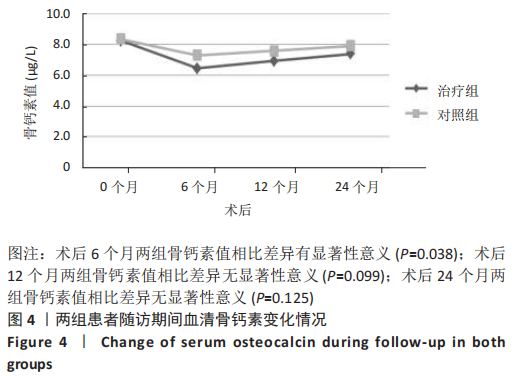
(2)血清TRACP-5b变化情况:见图5。
治疗组:术后6个月TRACP-5b自术前(2.25±0.35) U/L下
降至(2.00±0.29) U/L,与治疗前相比差异有显著性意义(P=0.011);术后12个月TRACP-5b变化至(1.76±0.26) U/L,
与治疗前相比差异有显著性意义(P=0.000);术后24个月TRACP-5b变化至(1.59±0.26) U/L,与治疗前相比差异有显著性意义(P=0.000);术后6个月与术后12个月之间的差异有显著性意义(P=0.007);术后6个月与术后24个月之间的差异有显著性意义(P=0.000);术后12个月与术后24个月之间的差异有显著性意义(P=0.034)。
对照组:术后6个月TRACP-5b自术前(2.24±0.54) U/L
下降至(2.19±0.52) U/L,与治疗前相比差异无显著性意义(P=0.717);术后12个月TRACP-5b变化至(2.06±0.52) U/L,与治疗前相比差异无显著性意义(P=0.234);术后24个月TRACP-5b变化至(2.01±0.51) U/L,与治疗前相比差异无显著性意义(P=0.121);术后6个月与术后12个月之间的差异无显著性意义(P=0.398);术后6个月与术后24个月之间的差异无显著性意义(P=0.224);术后12个月与术后24个月之间的差异无显著性意义(P=0.711)。

相同随访时间两组TRACP-5b值对比:术后6个月两组TRACP-5b值相比差异无显著性意义(P=0.134);术后12个月两组TRACP-5b值相比差异有显著性意义(P=0.019);术后24个月两组TRACP-5b值相比差异有显著性意义(P=0.001)。
2.5 骨质疏松变化情况 所有患者术前均确诊骨质疏松症(T值≤-2.5),在使用唑来膦酸后骨密度均有不同程度变化,见表6。
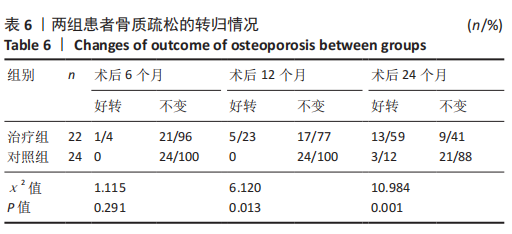
治疗组治疗6个月有1例患者骨密度自骨质疏松转变为骨含量减少,好转率为4%;治疗12个月共有5例患者骨密度自骨质疏松转变为骨含量减少,好转率为23%;治疗24个月后共有13例患者骨密度自骨质疏松转变为骨含量减少,好转率为59%。
对照组治疗6个月未见患者的骨密度自骨质疏松转变为骨含量减少,好转率为0;治疗12个月也未见患者骨密度自骨质疏松转变为骨含量减少,好转率亦为0;治疗24个月后共有3例患者骨密度自骨质疏松转变为骨含量减少,好转率为12%。
两组之间的变化在6个月时相比差异无显著性意义,12,24个月两组相比差异均有显著性意义。2年后未见患者的骨密度转变为正常,变化仅由骨质疏松转变为骨含量减少。
2.6 典型病例 女性患者,85岁,因摔伤致左髋部疼痛、活动受限4 d于2013-12-10入住云南省第一人民医院骨科。入院完善相关检查排除手术禁忌,与患者本人及家属充分沟通后行左侧人工股骨头置换,术后第5天下地行走。术后第3天给静脉输注唑来膦酸抗骨质疏松治疗,术后1年及2年2次静脉输注唑来膦酸,期间患者规律服用骨化三醇及钙剂。相关图片见图6。

2.7 植入物与宿主的生物相容性 两组病例植入物生物相容性好,均未出现植入物周围感染、过敏反应、免疫反应及排斥反应,见表7。
